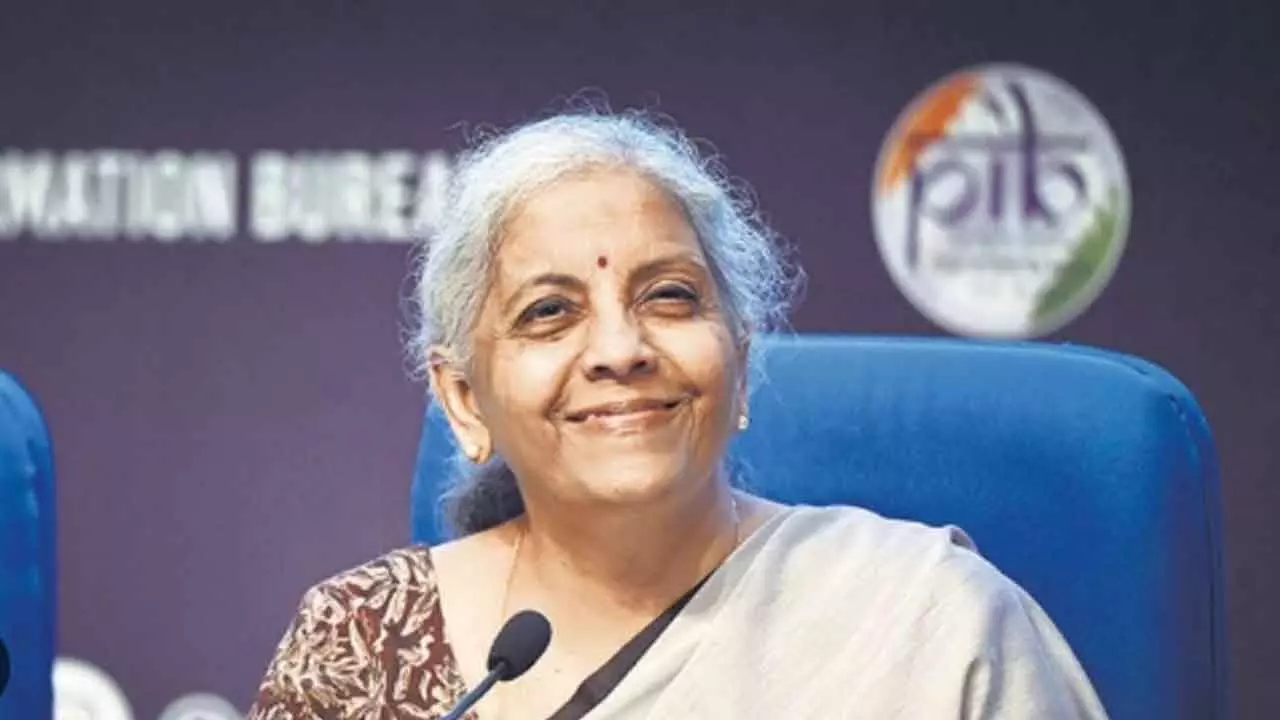Budget 2025 Lays Strong Foundation For A Balanced Economic Expansion
Focus is on infrastructure, MSMEs, investment, and sustainable development while maintaining fiscal prudence
Budget 2025 Lays Strong Foundation For A Balanced Economic Expansion

Budget presentation charts a visionary path towards Viksit Bharat. With a focus on inclusive growth, the Budget aims to strengthen India’s economy while ensuring fiscal discipline. Key measures include tax relief for the middle class, increased capex spending, and support for startups, agriculture, and exports
On February 1, 2026, Finance Minister Nirmala Sitharaman presented the Union Budget 2025-26, marking her historic eighth consecutive budget presentation. This budget was closely observed in light of India’s economic slowdown and global uncertainties impacting emerging economies. The projected economic growth for 2024-25 stands at 6.4 per cent, while the Economic Survey estimates GDP growth for 2025-26 to range between 6.3 per cent and 6.8 per cent. Addressing these challenges necessitates substantial reforms at both central and State levels, including deregulation, ease of doing business, and simplifications in land, labour, and industrial laws.
The industry, particularly manufacturing, exports, and MSMEs - key drivers of India’s growth - requires a supportive environment with reduced compliance burdens. Global trends indicate increasing protectionism, additional tariffs, and climate-related taxes, potentially affecting international trade. To counter this, India must adopt enablers that enhance global competitiveness. The Economic Survey highlighted the need for reducing regulatory burdens, lowering tariffs, liberalizing standards, and implementing risk-based regulations to support businesses and trade.
Domestically, sustained private sector investment, improved consumer confidence, and higher corporate wages are crucial for growth. The agricultural sector is rebounding, and easing food inflation should bolster rural consumption. To strengthen its medium-term growth potential, India must pursue grassroots-level structural reforms and deregulation.
Expectations from this budget included structural reforms, relief for the middle-income group to enhance purchasing power, and a continued focus on farmers, youth, women, and the underprivileged. A major debate centered on whether the government would increase fiscal deficit support to stimulate growth or rely on private sector investments. Capital expenditure, a key driver of infrastructure investment, was expected to receive continued prioritisation. The Union Budget 2025-26 was well-received for its inclusive, sustainable, and transformative measures.
The budget emphasised Viksit Bharat, targeting zero poverty, universal high-quality education, comprehensive healthcare, full employment with skilled labour, increased economic participation of women, and making India the "food basket of the world." A combination of macro and microeconomic policies aims to increase per capita income and achieve developed nation status by 2047. India is determined to avoid the middle-income trap and fully harness its economic potential through long-term growth strategies.
The budget addresses growth through following strategic pillars, strengthening the agriculture sector to achieve food security and global competitiveness- ensuring rural development and resilience through investments in infrastructure and employment generation, empowering all societal segments, particularly women and youth, encouraging domestic production and reducing import dependency, enhancing access to credit and reducing compliance burdens for micro and small enterprises, focusing on skilling initiatives and job creation, strengthening education, healthcare, and technological advancements, promoting renewable energy and achieving sustainable power sector growth, enhancing India’s global trade position through supportive policies, and encouraging startups, fintech, and new enterprises.
The budget strategically focuses on four growth engines: agriculture, MSMEs, investment, and exports, supplemented by innovation, technology adoption, and deregulation. To accelerate economic transformation, six key reform domains were identified. They included taxation, power sector, urban development, mining, financial sector and regulatory reforms.
The budget also incentivizes state-level reforms by providing additional fiscal buffers and long-term interest-free loans. Swift execution of these reforms is essential for maximizing India’s growth potential and achieving the Viksit Bharat vision.
Despite ambitious allocations, the government remains committed to fiscal prudence. The fiscal deficit target is set at 4.8 per cent for FY 2025 and 4.4 per cent for FY 2025-26, aligning with the goal of reducing the debt-to-GDP ratio to 50 per cent by 2031 from the projected 55.1 per cent in 2025-26. This compares favorably with advanced economies such as Japan, the US, the UK, and France, which have significantly higher debt-to-GDP ratios.
Capital expenditure (capex) remains a priority, increasing 10.1 per cent year-on-year to Rs11.2 lakh crore, with an annualized growth of 20.3 per cent since the pre-pandemic period. Capex remains at 3.1 per cent of GDP, while total planned capex, including state grants and CPSE investments, stands at Rs19.79 lakh crore (5.5 per cent of GDP). With gross borrowings projected at Rs14.73 lakh crore, net borrowing remains at a favorable Rs11.54 lakh crore, allowing banks to enhance corporate credit availability.
To boost household consumption and savings, tax exemptions have been increased to Rs12 lakh, with an additional Rs75,000 for salaried employees. This initiative is expected to inject approximately Rs1 lakh crore into the economy, significantly enhancing spending power. According to the SBI report, this could result in an overall consumption boost of Rs3.3 lakh crore.
For MSMEs, the budget expands investment and turnover limits by 2.5 times and 2 times, respectively. A special Micro Enterprises Credit Card with a Rs5 lakh limit is being introduced, aiming to issue 10 lakh cards in the first year. Additionally, a Rs10,000 crore Fund of Funds is set up for MSMEs, and a separate scheme provides Rs5 lakh in funding for women, SC/ST entrepreneurs, offering term loans of up to Rs2 crore over the next five years. These measures will significantly strengthen MSMEs' contribution to economic growth.
The budget reinforces India’s commitment to a green economy, reducing carbon emissions, and expanding the EV ecosystem.
In conclusion, the Union Budget 2025-26 is a people-centric, inclusive, and comprehensive blueprint aligned with the vision of Viksit Bharat. It lays a strong foundation for long-term economic transformation while balancing fiscal prudence. Through reforms, investment, sustainability, and innovation, the budget ensures that India stays on the path to becoming a developed economy by 2047, fostering prosperity and growth for all.
(The author is former Chairman & Managing Director of Indian Overseas Bank)

